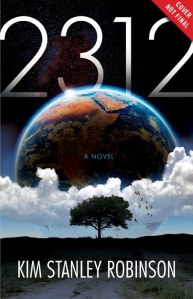Publisher: Orbit
Pages: 576
Year: 2012
Buy: Hardback, Kindle
Source: Bought copy
 Review
Review
Two novels for me have had irresistible covers this year. The first was Blue Remembered Earth by Alastair Reynolds and the second is 2312 by Kim Stanley Robinson. It’s not surprising that both covers appeal because they have a lot in common but, after a week reading 2312, I can see that the similarities extend deeper than the surface and each complements the other. Both present our solar system populated by humans, descended from men and women driven from earth during its environmental devastation. On a more intimate level, they both portray the impact of the death of a loved yet unknowable and powerful woman on her grandchildren. If you’ve read either of these two books, then I suggest you read the other as well.
In 2312 we have a solar system in the process of being terraformed. Some planets and moons, such as Mars, have advanced far along this path, with breathable atmospheres. Others, like Venus and Mercury, have adapted to the extreme hostility of an overhot sun with heatshields or cities that move along tracks to keep themselves in the shade and safe. Travel between the planets and moons takes place on asteroids, the insides of which have been terraformed into as many different environments as one can imagine – seas, African plains, jungles, sex liners, urbane French kingdoms, blackness, paradises.
All of which contrasts with a largely drowned earth which noone has the power – or will – to terraform. But it isn’t all gloom for earth. New York City has become a new glorious Venice, the lower floors of its skyscrapers lie beneath the water level while the inhabitants travel between the glass towers by boat or bridge, and spend time on plazas in the sky.
Swan Er Hong is our guide. Once a builder of these worlds, she is now a performance artist and one of Mercury’s sunwalkers. The sunwalkers risk death to follow the sun on its path across the planet. Always keeping just in its shadow, they marvel at the shapes that the sun carves into the surface of Mercury and leave their own works of art. Mercury is full of art – it has galleries containing masterpieces from sodden earth, its craters and peaks are named after artists and great musical events take place outside the safety of Terminator, the city on tracks.
When Terminator, her home, is destroyed, Swan finds herself caught up in a conspiracy, following in the steps of her recently deceased grandmother Alex, chasing the clues that Alex has left across the solar system.
2312 is a novel that intrigues on so many levels. It is, on the surface, a mystery or thriller but this is quite possibly the least important element of the novel. What makes 2312 such an enjoyable read is its world-building. This is astonishing. The physical environments that Swan finds herself in are full of surprises and delights. These are refined further with little touches of music, poetry, debate and art. The character of Swan and that of Wahram and Inspector Genette are equally rounded and fascinating. Animal imagery surrounds them and gives them character and during different trials each comes into his or her own.
This is a universe in which old age and natural death are in the process of being defeated. Gender is becoming blurred. People experiment with biological additions or symbiosis and human intelligence is heightened by qubes, artificially intelligent implants. In this universe, each person has evolved themselves into something very different from anyone else. Therefore, the love story between Swan and Wahram is all the richer and more moving.
The narrative is interrupted throughout with ‘lists’ and ‘extracts’ which might distract from the thriller element of the novel but they enrich the world-building and, as 2312 continues, their relevance becomes clearer (or, more accurately, more susceptible to interpretation). In fact, the strengths of the novel increasingly overshadow the ‘plot’, which moves too slowly and confusingly, even irrelevantly.
Kim Stanley Robinson lightens his ‘heavy’ science fiction with a deft touch. The Mars here is not the same Mars from his famous trilogy. This solar system is a new creation and it is in places enchanting and always fascinating. There are scenes and ideas here which are unforgettable. Overlook the mystery and immerse yourself instead in the world and worlds of Swan and Wahram.
